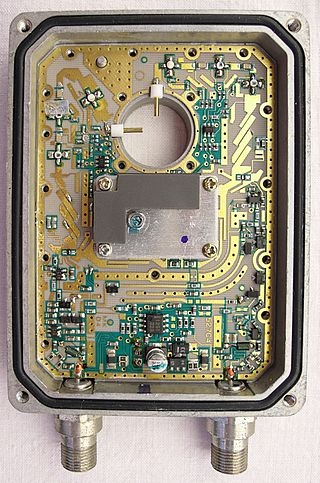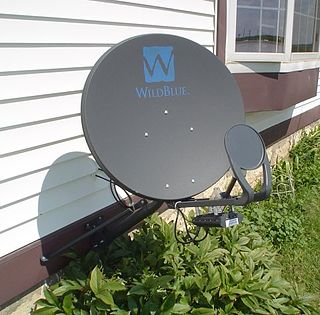
In telecommunications and computer networking, multiplexing is a method by which multiple analog or digital signals are combined into one signal over a shared medium. The aim is to share a scarce resource – a physical transmission medium. For example, in telecommunications, several telephone calls may be carried using one wire. Multiplexing originated in telegraphy in the 1870s, and is now widely applied in communications. In telephony, George Owen Squier is credited with the development of telephone carrier multiplexing in 1910.

Network topology is the arrangement of the elements of a communication network. Network topology can be used to define or describe the arrangement of various types of telecommunication networks, including command and control radio networks, industrial fieldbusses and computer networks.
In a telecommunications network, a link is a communication channel that connects two or more devices for the purpose of data transmission. The link may be a dedicated physical link or a virtual circuit that uses one or more physical links or shares a physical link with other telecommunications links.

Telecommunications in Australia refers to communication in Australia through electronic means, using devices such as telephone, television, radio or computer, and services such as the telephony and broadband networks. Telecommunications have always been important in Australia given the "tyranny of distance" with a dispersed population. Governments have driven telecommunication development and have a key role in its regulation.

In space mission design, a geostationary transfer orbit (GTO) or geosynchronous transfer orbit is a highly elliptical type of geocentric orbit, usually with a perigee as low as low Earth orbit (LEO) and an apogee as high as geostationary orbit (GEO). Satellites that are destined for geosynchronous orbit (GSO) or GEO are often put into a GTO as an intermediate step for reaching their final orbit. Manufacturers of launch vehicles often advertise the amount of payload the vehicle can put into GTO.
A satellite dish is a dish-shaped type of parabolic antenna designed to receive or transmit information by radio waves to or from a communication satellite. The term most commonly means a dish which receives direct-broadcast satellite television from a direct broadcast satellite in geostationary orbit.
Frequency-division multiple access (FDMA) is a channel access method used in some multiple-access protocols. FDMA allows multiple users to send data through a single communication channel, such as a coaxial cable or microwave beam, by dividing the bandwidth of the channel into separate non-overlapping frequency sub-channels and allocating each sub-channel to a separate user. Users can send data through a subchannel by modulating it on a carrier wave at the subchannel's frequency. It is used in satellite communication systems and telephone trunklines.

A low-noise block downconverter (LNB) is the receiving device mounted on satellite dishes used for satellite TV reception, which collects the radio waves from the dish and converts them to a signal which is sent through a cable to the receiver inside the building. Also called a low-noise block, low-noise converter (LNC), or even low-noise downconverter (LND), the device is sometimes inaccurately called a low-noise amplifier (LNA).

Internet access is a facility or service that provides connectivity for a computer, a computer network, or other network device to the Internet, and for individuals or organizations to access or use applications such as email and the World Wide Web. Internet access is offered for sale by an international hierarchy of Internet service providers (ISPs) using various networking technologies. At the retail level, many organizations, including municipal entities, also provide cost-free access to the general public.
The S band is a designation by the Institute of Electrical and Electronics Engineers (IEEE) for a part of the microwave band of the electromagnetic spectrum covering frequencies from 2 to 4 gigahertz (GHz). Thus it crosses the conventional boundary between the UHF and SHF bands at 3.0 GHz. The S band is used by airport surveillance radar for air traffic control, weather radar, surface ship radar, and some communications satellites, particularly satellites used by NASA to communicate with the Space Shuttle and the International Space Station. The 10 cm radar short-band ranges roughly from 1.55 to 5.2 GHz. India's regional satellite navigation network (IRNSS) broadcasts on 2.483778 to 2.500278 GHz.

Satellite Internet access is Internet access provided through communication satellites; if it can sustain high speeds, it is termed satellite broadband. Modern consumer grade satellite Internet service is typically provided to individual users through geostationary satellites that can offer relatively high data speeds, with newer satellites using the Ku band to achieve downstream data speeds up to 506 Mbit/s. In addition, new satellite internet constellations are being developed in low-earth orbit to enable low-latency internet access from space.

Bell Satellite TV is the division of BCE Inc. that provides satellite television service across Canada. It launched on September 10, 1997. As of April 2017, Bell Satellite TV provides over 700 channels to over 1 million subscribers. Its major competitors include satellite service Shaw Direct, as well as various cable and communications companies across Canada.

Internet Protocol television (IPTV), also called TV over broadband, is the service delivery of television over Internet Protocol (IP) networks. Usually sold and run by a telecom provider, it consists of broadcast live television that is streamed over the Internet (multicast) — in contrast to delivery through traditional terrestrial, satellite, and cable transmission formats — as well as video on demand services for watching or replaying content (unicast).

The history of mobile phones covers mobile communication devices that connect wirelessly to the public switched telephone network.
In telecommunications, cable Internet access, shortened to cable Internet, is a form of broadband internet access which uses the same infrastructure as cable television. Like digital subscriber line and fiber to the premises services, cable Internet access provides network edge connectivity from the Internet service provider to an end user. It is integrated into the cable television infrastructure analogously to DSL which uses the existing telephone network. Cable TV networks and telecommunications networks are the two predominant forms of residential Internet access. Recently, both have seen increased competition from fiber deployments, wireless, mobile networks and satellite internet access.

An amateur radio repeater is an electronic device that receives a weak or low-level amateur radio signal and retransmits it at a higher level or higher power, so that the signal can cover longer distances without degradation. Many repeaters are located on hilltops or on tall buildings as the higher location increases their coverage area, sometimes referred to as the radio horizon, or "footprint". Amateur radio repeaters are similar in concept to those used by public safety entities, businesses, government, military, and more. Amateur radio repeaters may even use commercially packaged repeater systems that have been adjusted to operate within amateur radio frequency bands, but more often amateur repeaters are assembled from receivers, transmitters, controllers, power supplies, antennas, and other components, from various sources.
Monsoon Multimedia was a company that manufactured, developed and sold video streaming and place-shifting devices that allowed consumers to view and control live television on PCs connected to a local (home) network or remotely from a broadband-connected PC or mobile phone. It was one of 5 major transformations initiated by Prabhat Jain, a Silicon Valley entrepreneur with 5 undergraduate and post graduate engineering degrees from Cal Berkeley and Univ of Vienna, Austria. On the even of Cisco acquiring Monsoon in 2017, EchoStar, the new parent of Sling sued Monsoon for patent infringement, having obtained confidential information about the date of the acquisition by Cisco from a Monsoon employee under murky circumstances. Monsoon settled the lawsuit by agreeing not to sell its products in the USA simply because it did not have the legal funds to fight mighty Echostar's legal maneuvers. EchoStar thus successfully removed its only competitor from the market place. This meant Monsoon's death knell.
SES Broadband is a two-way satellite broadband Internet service available across Europe, which launched in March 2007, and uses the Astra series of geostationary satellites.
Telecommunications in Antarctica is provided by the organizations that have established research stations on the continent. Antarctica is not formally designated by the International Telecommunication Union (ITU) in any of the world zones.

Bell Fibe TV is an IP-based television service offered by Bell Canada in the provinces of Ontario and Quebec. It is bundled with a FTTN or FTTH Bell Internet service, and uses the Mediaroom platform. Bell Fibe TV officially launched on September 13, 2010. It is also available in Manitoba and Atlantic Canada, where Fibe TV is re-packaged, being offered by Bell MTS and Bell Aliant with similar services and integrated with Bell Fibe TV.










